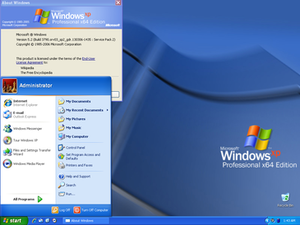
Back Windows XP#64 bits Catalan Windows XP Professional x64 Edition Czech Windows XP Professional x64 Edition Greek Windows XP Professional x64 Edition Spanish Microsoft Windows XP 64 French Windows XP Professional x64 Edition Armenian Windows XP Professional x64 Edition Italian Microsoft Windows XP Professional x64 Edition Japanese 윈도우 XP 프로페셔널 x64 에디션 Korean Windows XP Professional x64 Edition Dutch
 Screenshot of Windows XP Professional x64 Edition running the Luna visual style, showing the start menu and the "About Windows" window | |
| Developer | Microsoft |
|---|---|
| OS family | Windows NT |
| Working state | No longer supported |
| Source model | |
| Initial release | April 25, 2005[1] |
| Final release | Service Pack 2 with May 14, 2019 security update (5.2.3790.6787) / April 19, 2019[2] |
| Kernel type | Hybrid (NT) |
| Default user interface | Graphical user interface |
| License | Proprietary commercial software |
| Official website | Windows XP Professional x64 Edition overview (archived at Wayback Machine) |
| Support status | |
| Mainstream support ended on April 14, 2009.[3] Extended support ended on April 8, 2014.[3] | |
| Part of a series of articles on |
| Windows XP |
|---|
| Siblings |
Windows XP Professional x64 Edition is an edition of Microsoft's Windows XP operating system that supports the x86-64 architecture. It was released on April 25, 2005, alongside the x86-64 versions of Windows Server 2003.
Windows XP Professional x64 Edition is designed to use the expanded 64-bit memory address space provided by the x86-64 64-bit extensions to the x86 IA-32 architecture,[1] which was implemented by AMD as "AMD64", found in AMD's Opteron, Athlon 64 chips (and in selected Sempron processors), and implemented by Intel as "Intel 64" (formerly known as IA-32e and EM64T), found in some of Intel's Pentium 4 and most of Intel's later chips since the Core series.
Windows XP Professional x64 Edition uses the same kernel and code tree as Windows Server 2003[4] and is serviced by the same service packs.[5] However, it includes client features of Windows XP such as System Restore, Windows Messenger, Fast User Switching, Welcome Screen, Security Center and games, of which Windows Server 2003 does not have.
During the initial development phases (2003–2004), Windows XP Professional x64 Edition was named Windows XP 64-Bit Edition for 64-Bit Extended Systems[6] and later as Windows XP 64-Bit Edition for Extended Systems, as opposed to 64-Bit Edition for Itanium Systems for Windows XP 64-Bit Edition, as the latter was designed for the IA-64 (Itanium) architecture.[7][8]
- ^ a b "Microsoft Raises the Speed Limit with the Availability of 64-Bit Editions of Windows Server 2003 and Windows XP Professional" (Press release). Microsoft. April 25, 2005. Retrieved September 10, 2015.
- ^ "Description of the security update for the remote code execution vulnerability in Windows XP Professional x64 Edition SP2". Microsoft. May 14, 2019.
- ^ a b "Microsoft Product Lifecycle: Microsoft Windows XP Professional x64 Edition". Support. Microsoft. Archived from the original on July 21, 2015. Retrieved October 15, 2014.
- ^ "A description of the x64-based versions of Windows Server 2003 and of Windows XP Professional x64 Edition (Revision 3.8)". Support. Microsoft. October 11, 2007. Retrieved January 12, 2011.
The x64-based versions are based on the Windows Server 2003 code tree. Service and support activities for these versions use the Windows Server 2003 tree and do not use the Windows XP client tree.
- ^ Oiaga, Marius (December 14, 2007). "64-Bit Windows XP Service Pack 3? Don't think so... at least for now". Softpedia. SoftNews. Retrieved October 15, 2014.
- ^ "Microsoft Announces Beta Version of Windows XP 64-Bit Edition For 64-Bit Extended Systems". News Center. Microsoft. September 23, 2002. Retrieved June 7, 2013.
- ^ "Microsoft Releases Windows XP 64-Bit Edition Version 2003 to Manufacturing". News Center. Microsoft. March 28, 2003. Retrieved January 12, 2011.
- ^ Evers, Joris (January 4, 2005). "Microsoft nixes Windows XP for Itanium". InfoWorld. IDG. Archived from the original on January 5, 2005. Retrieved January 12, 2011.